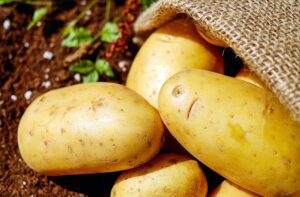Introduction
Ever wonder what to plant after potatoes? Considering growing peas or beans after potatoes! These legumes enrich the soil with nitrogen and help break disease cycles, ensuring a healthy and abundant garden. Explore other diverse crop rotation for sustainability.
The Importance of Crop Rotation
Crop rotation, the practice of growing different types of crops in the same area across different seasons, is a critical aspect of sustainable agriculture. It helps to enhance soil fertility and structure, prevent the buildup of pests and diseases, and increase crop yield. Rotating crops reduces the strain on soil resources, as different plants have varying nutrient requirements. Furthermore, it discourages the proliferation of crop-specific pests and diseases, promoting a healthier, more productive garden.
Beneficial Crops to Plant After Potatoes
Planting certain crops after potatoes can be advantageous for a few reasons. First, potatoes are heavy feeders that deplete soil nutrients, particularly nitrogen. Crops such as beans and peas, which are legumes, can replenish these lost nutrients because they have a unique ability to fix nitrogen from the atmosphere and deposit it back into the soil. Secondly, these crops also have different pest and disease profiles compared to potatoes, which can help disrupt the life cycles of any potato-specific pests or diseases left in the soil, reducing their populations. Finally, certain crops have deep root systems that can help break up the soil, improving its structure after the potato harvest. This increased soil aeration promotes better water and nutrient uptake for future crops.
Legumes
Peas and Beans
Peas and beans are both members of the legume family, making them an excellent choice to plant after potatoes. They are known for their nitrogen-fixing properties, an ability that is attributed to the presence of a special type of bacteria in their root nodules. These bacteria convert atmospheric nitrogen into a form that plants can use, effectively replenishing the soil’s nitrogen content. This is especially beneficial after growing potatoes, which are heavy consumers of soil nutrients. In addition to their role in soil health, peas and beans also add variety to the garden, producing tasty and nutritious harvests. Their differing growth habits and pest profiles can help disturb pest and disease cycles, further enhancing the health of your garden.
Brassicas
Cabbage, Kale, and Brussels Sprouts
Cabbage, Kale, and Brussels Sprouts belong to the Brassica family, another good option for planting after potatoes. These vegetables benefit from the improved soil structure after the potato harvest. Brassicas are particularly adept at extracting nutrients from deep within the soil through their extensive root systems which can reach where potato roots did not. This not only helps them to thrive but also aids in further improving the soil’s fertility. Brassicas have different pest and disease profiles from potatoes. Therefore, planting them after potatoes can help break any potato-specific pest or disease cycles. Furthermore, these crops are highly nutritious and can add variety to your kitchen garden.
Benefits: Heavy feeders that can make use of the extra nutrients
Leafy Greens
Lettuce and Spinach
Lettuce and Spinach are examples of leafy greens that are excellent for planting after potatoes. These greens sprout fast and mature quickly, making them an ideal choice for getting a quick harvest and keeping your garden productive in between more substantial crops. Besides, their shallow, fibrous root systems are excellent for soil structure. They help to stabilize the soil, preventing erosion while also breaking down heavy clods. The presence of these leafy greens in your rotation can help to ensure the continued health and fertility of your garden soil. Their addition to your garden also brings a variety of nutritional benefits, enriching your table with fresh, homegrown leafy greens.
Root Vegetables
Carrots and Beets
Carrots and beets are root vegetables that you might consider planting after potatoes. These veggies are known for their capacity to thrive in well-draining soil, which is a common characteristic of land post-potato cultivation. Their long taproots can penetrate deeply into the soil, often reaching untouched soil layers, which allows them to access nutrients that surface-rooted plants can’t reach. This can contribute to the overall fertility of your garden. However, it’s important to note that some root vegetables might not be the ideal choice to follow potatoes due to potential disease carryover. Diseases affecting potatoes can sometimes persist in the soil and affect subsequent root crops. Therefore, it’s recommended to thoroughly research and maybe even test the soil before deciding on the next crop after potatoes.
Conclusion
In conclusion, when deciding what to plant after potatoes, leafy greens and certain root vegetables are good options. Quick-growing leafy greens such as lettuce, spinach, and arugula can increase garden productivity and enhance soil structure, contributing to its overall health and fertility. Root vegetables like carrots and beets are another viable choice due to their ability to thrive in well-draining soil and reach untouched soil layers through long taproots. However, potential disease carryover is a concern when following potatoes with root vegetables. Therefore, it’s crucial to research and possibly test your soil before making a final decision. These crops not only ensure a productive garden but also provide a range of nutritional benefits.
Final Thoughts
Maintaining soil health and practicing crop rotation is not merely a method to sustain garden productivity, but a commitment to the environment and food security. Diverse crop rotation, including the planting of cover crops, can drastically improve soil structure, enhance its nutrient content, and break the cycle of pests and diseases. Implementing a well-planned rotation sequence can also lead to increased crop yields and the sustainability of your garden, while reducing the reliance on chemical fertilizers and pesticides. Lastly, remember that the health of your garden is an ongoing process. Regular soil tests and adjustments based on those results can ensure your garden thrives season after season, providing a bountiful harvest for your table. Let’s embrace these practices, for they contribute not only to our wellbeing but also towards a sustainable and resilient global food system.


